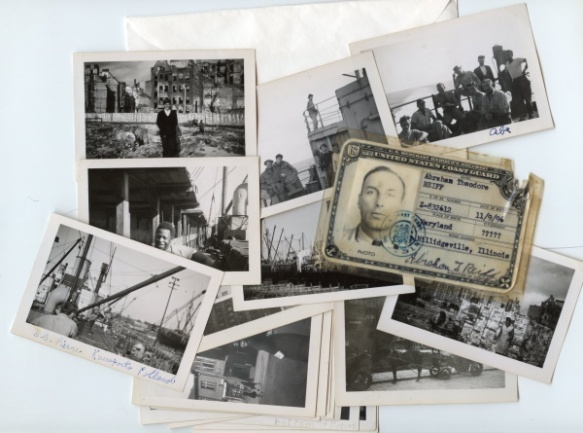This will be a more personal post. At my presentations, I am often asked how I got into this seagoing cowboy history. So today, I’ll share that story with you.
It all started with an envelope of my Grandpa Abe’s photos my father gave me some years after grandpa died.
 Turns out, Grandpa Abe had been a seagoing cowboy, accompanying a load of horses to Poland the end of September 1946.
Turns out, Grandpa Abe had been a seagoing cowboy, accompanying a load of horses to Poland the end of September 1946.
I grew up in the Church of the Brethren, the denomination responsible for recruiting all of the livestock tenders for UNRRA’s shipments of farm animals to Europe after World War II. From my youth magazines, I knew about these “seagoing cowboys.” But I DIDN’T know that my grandpa had been one of them. He never talked about it with us grandkids, and we never knew to ask. I knew there were a couple of Polish dolls in grandpa’s attic where we grandkids often played, but I didn’t make the connection until seeing his photos.
After receiving that envelope of photos, I got curious about what grandpa’s trip may have been like. So in January 2002, I interviewed a man from our church, Al Guyer, who I knew had been a seagoing cowboy to Poland. The end of that year, I signed up for a book writing course through the Institute of Children’s Literature to write a young adult novel. Grandpa’s photos and stories of Al Guyer’s eventful trip kept beckoning to me, and I thought, what a great topic! The trip of a 16-year-old seagoing cowboy to Poland! My instructor agreed. The topic was “something new and different under the sun,” she said. Being historical fiction, it would require a great deal of research, so I sought out more seagoing cowboys to interview.

Interviewing J. O. Yoder about his trip to Poland on the S. S. Clarksville Victory in December 1945.
One cowboy led to another, and another, and another. And their stories were so fascinating and compelling that I was hooked! It didn’t take long to realize that this was a rich history, just hiding away in people’s minds, and drawers, and attics, and my mission changed to that of documenting this little-known, not-to-be-forgotten history of how men of all stripes delivered hope to a war-torn world. I’ve been at it for twenty years now, accumulating a sizable archive of cowboy photos and stories too significant to just sit on my shelves.
In 2007, I created a DVD documentary photostory, A Tribute to the Seagoing Cowboys, which I took on a Tribute Tour around the country meeting more cowboys and gathering their stories.

Meeting and hearing from seagoing cowboys at Brethren Village retirement community in Lititz, PA, April 14, 2009.
I started my seagoing cowboys website in 2008, and what a game changer that was! I began to get requests for information of all types related to this history from as far away as Poland, Germany, Finland, and Japan. Inadvertently, I had become the recognized “expert” on the seagoing cowboys and the related history of the Heifer Project.
My novel did get drafted and revised, and revised, and revised, but never published. Instead, it sort of morphed into my children’s picture book The Seagoing Cowboy. In the summer of 2014, while that book was in the works, I decided the best way to get more of this history out into the world was to start a blog. And I’ve been at it ever since.

Beautiful to read your path to purpose that has served so many across the globe as I’m in the midst of finding my own again.
Thanks for bringing light to this service with your own.
with gratitude,
Stephanie
LikeLiked by 1 person
Best wishes in finding your own path, Stephanie.
LikeLike
I think a better title of this post would be, “How a Novel Became a Calling”!
LikeLike
You’re absolutely right, Judy! And you’ve been by my side through the bulk of that journey. Thanks!
LikeLiked by 1 person
Thank you, Peggy. Reading your blog reignited my interest in my own family seagoing cowboy relatives. I love that you are the curator of so many memories that would have been lost. What a wonderful accomplishment.
LikeLike
Thanks, Michelle! It has been the joy of reviving stories within families that has kept me energized for this work.
LikeLiked by 1 person
Thank you so much for your work. I regret not talking with my father more about his adventure. But I did get to visit Trieste earlier this year so walking in his footsteps was a huge event for me. I’m currently working on an album of photos comparing Trieste in 1946 and 2022 which wouldn’t have been possible without you.
LikeLiked by 1 person
That’s wonderful, Don! I’d love to see your album when you get it finished. I have comparisons for Gdansk, Poland, but none for elsewhere that the cowboys went. As much as getting to the ports in Italy and Greece are on my bucket list, I don’t know if that will ever happen.
LikeLike
Absolutely!
LikeLike
Great story!
LikeLiked by 1 person